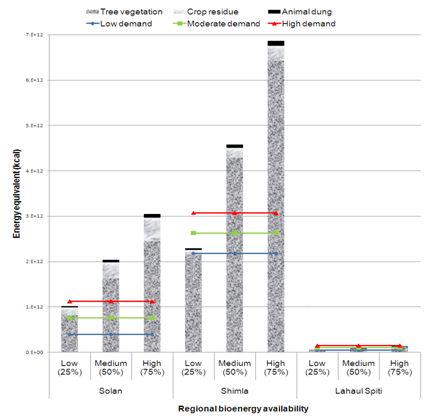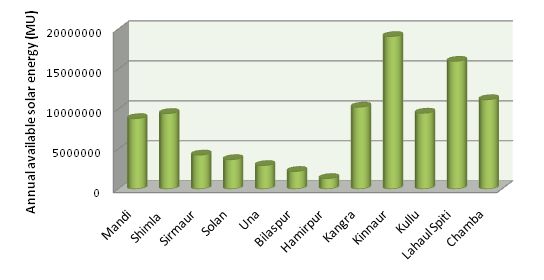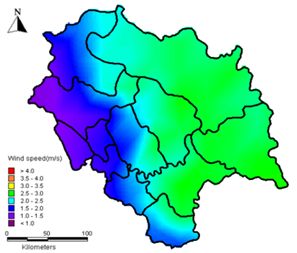|
Renewable energy resources in Himachal Pradesh
Bioenergy: Bioenergy includes energy derived from combustion or digestion of organic materials like wood, animal dung, agricultural residues etc[17]. Our study was based on three districts of Himachal Pradesh, exhaustively representative of lower (tropical to sub-tropical), middle (sub-tropical to wet-temperate) and higher (dry-temperate to alpine) elevation zones: Solan, Shimla and Lahaul Spiti respectively. Field surveys and literatures estimated that Per Capita Fuel Consumption (PCFC) varies seasonally and regionally as 0.48–1.32 kg/person/day in Solan, 1.9–2.68 kg/person/dayin Shimla and 0.89–2.91 kg/person/day in Lahual Spiti wherein the increase in thermal energy demand with increase in elevation is evident. Satellite imageries and remote sensing tools are used to deduce the total tree cover in the study area providing annual woody biomass of 517.3–1111.7 kilo tonnes in Solan, 1253.8–3029.8 kilo tonnesin Shimla and 18.9–63.8 kilo tonnesin Lahaul Spiti. This clearly shows the lowest availability of fuelwood in the regions of highest thermal energy demand per capita.
It must be seen if other bioenergy sources are able to supplement this scarcity. The annual bioenergy from agro residues (considering 50% for fuel purpose and the remaining for agricultural practices) like cereals, pulses, oilseeds, cotton and sugarcane grown in the state: 349463 million kcal in Solan, 221562 million kcal in Shimla and 2678 million kcal in Lahaul Spiti, shows highest availability of residues in lower elevation zone represented by Solan. The annual biogas generation potential from animal dung: 8.7–35.6 million m3 in Solan, 12.9–43.2 million m3 in Shimla and 0.8–1.9 million m3 in Lahaul Spiti, shows highest availability in middle elevation zone represented by Shimla. Agro-residues and biogas based bioenergy in Lahaul Spiti representing the higher elevation zone are limited due to sparse population. Other studies show that, the state has an estimated potential to install nearly 0.332 million family size (2 m3) biogas plants producing 0.515 million m3 of biogas per day with energy equivalent to about 1801.1 tonnes of fuelwood. However, due to technical, organizational and social influences, biogas program introduced in the state in 1982 was not successful [18].
With increasing population trends in higher elevation zone and limited energy resources to meet the demand, a resource crunch is created resulting in disastrous ecological impact. Scenarios wherein the thermal energy demands (low, medium or high) of a region are not met by the bioenergyfrom wood, agro-residue or animal dung based on 25%, 50% or 75% availability of the resource (Figure 2), call for immediate attention torenewable energy alternatives.
Figure 2: Scenarios of bioenergy availability (25%, 50%, 75%) and thermal energy demand (low, medium, high) in Solan, Shimla and LahaulSpiti districts of Himachal Pradesh

Solar energy: Solar resource availability in the state of Himachal Pradesh was assessed using reliable satellite based data from National Aeronautics and Space Administration (NASA) and National Renewable Energy Laboratory (NREL). Spatial analyses using Geographical Information Systems (GIS) shows that the state receives average Global Horizontal Insolation (GHI) above 4.5 kWh/m2/day and a total of 98586056 MU annually (district wise availability given in Figure 3). Seasonally, Himachal Pradesh receives an average insolation of 5.86±1.02 – 5.99±0.91 kWh/m2/day in the summer months of March, April, May; 5.69±0.65 – 5.89±0.65 kWh/m2/day in the monsoon months of June, July, August, September; a little lower 3.73±0.91 – 3.94±0.78 kWh/m2/day in the winter months of end October, November, December, January, February. The regional availability of GHI in Himachal Pradesh is influenced by its topography, seasons as well as microclimate. Study based on elevation gradient shows that the tropical to wet-temperate zone receives higher GHI (>5 kWh/m2/day) for a major part of the year compared to the higher dry-temperate to alpine zone (4-4.5 kWh/m2/day) annually[19]. The former zone is represented by the districts of Solan and Shimla while latter zone by Lahaul Spiti.
Figure 3: Disctrict wise annual availability of solar energy in Himachal Pradesh [12]

The comparatively energy intensive livelihoods in tropical to wet-temperate zone, for example, extensive horticulture due to increased commercialization could rely on the substantial solar energy available. Solar cookers in households and communities should be encouraged to reduce fuelwood use for cooking. The colder and higher elevation zones could utilize solar energy for: a) room/water heating which significantly reduces dependence on fuelwood, b) lighting based on photovoltaic technologies especially in isolated and un-electrified pockets[20-21].
Wind energy: Wind resource availability in the complex terrain of Himachal Pradeshhas been explored considering the fact that wind speeds vary largely based on microclimatic conditions. Since surface wind speed measurements were available only for 13 locations, higher resolution wind speed values were collected from NASA and Climate Research Unit (CRU). These data were scrutinized to evaluate the most probable wind speeds within the state. The data obtained from Climate Research Unit (UK) provided preliminary understanding of wind regime that helps in identifying potential sites for further wind prospecting. Wind speed values mostly below 4 m/s showed that large scale commercial power generation might not be feasible in Himachal Pradesh. The middle and higher elevation zone in the statehas relatively higher wind speeds compared to lower tropical zones (Figure 4). These speeds are favorable for small wind technologies like agricultural water pumps, wind-photovoltaic hybrids, space/water heaters etc. whichmight help in meeting part of the energy demand sustainably. Ground validation and site specific studiesare highly prescribed beforeinstalling wind energy technologies[22-23].
Figure 4: Annual average wind speeds in Himachal Pradesh (data from CRU,UK)

Other renewables: Himachal Pradesh has one–third of its geographical area snow covered for seven months and regions above 4500 m experiencing perpetual snowfall and rainfall. These form basis for many streams, rivulets and rivers ideal for small-hydro projects meeting local electricity demands with minimal environmental consequences.Reports say that, 323 small-hydro sites were identified in the state with total capacity of 1625 MW out of which 52 projects were completed with capacity of 114 MW. In the urban areas, Municipal Solid Waste (MSW) generation ranges from 0.25 to 0.66 kg/person/day. Large quantities of solid and liquid wastes generated by industries could also be effectively treated and utilized effectively for energy 16. Such possibilities of alternative renewable energy utilization are to be identified in the state on an extremely regional level[24].
|




